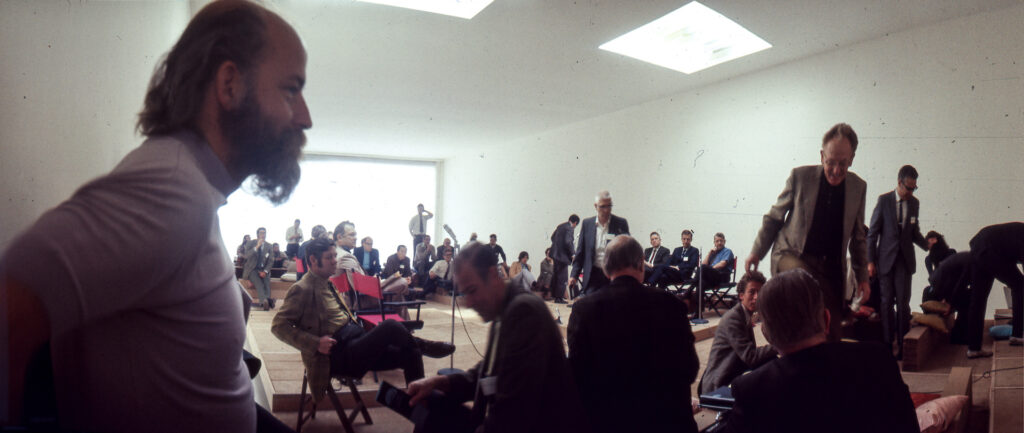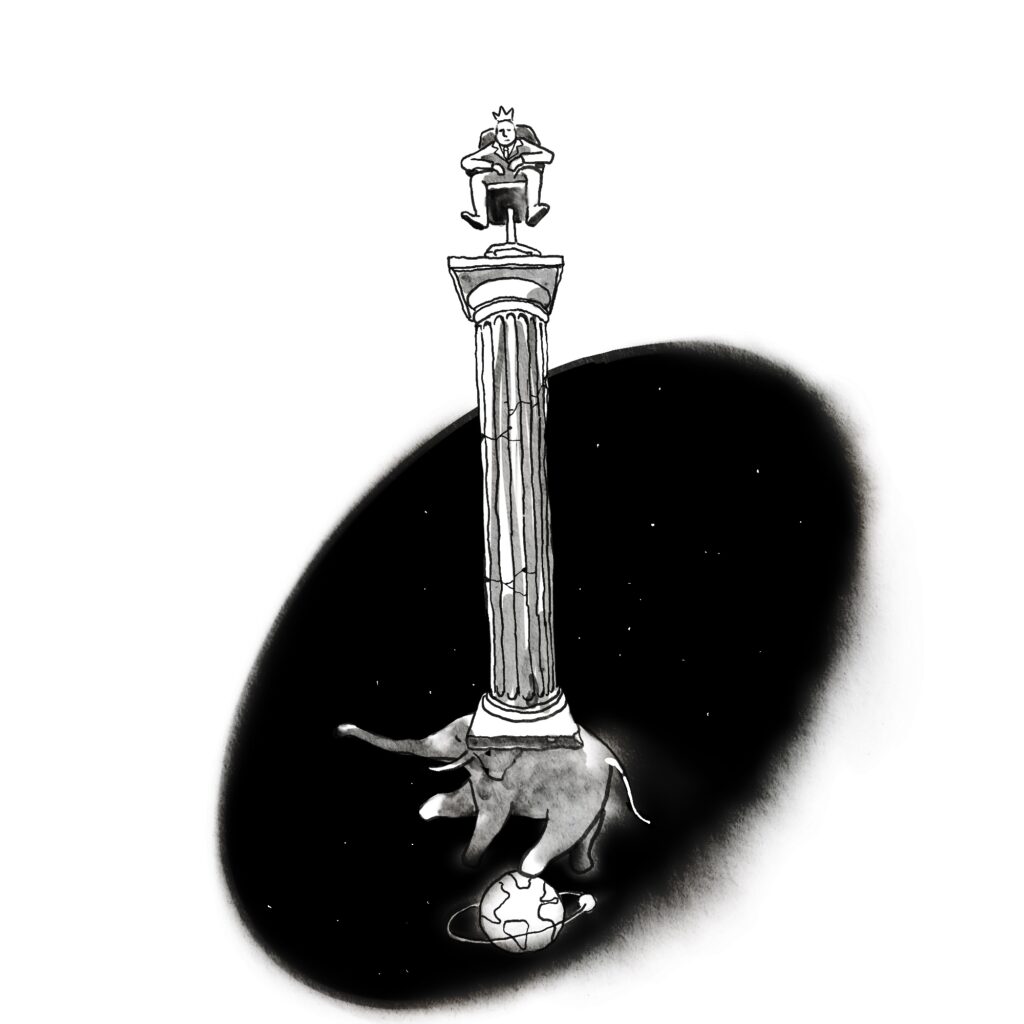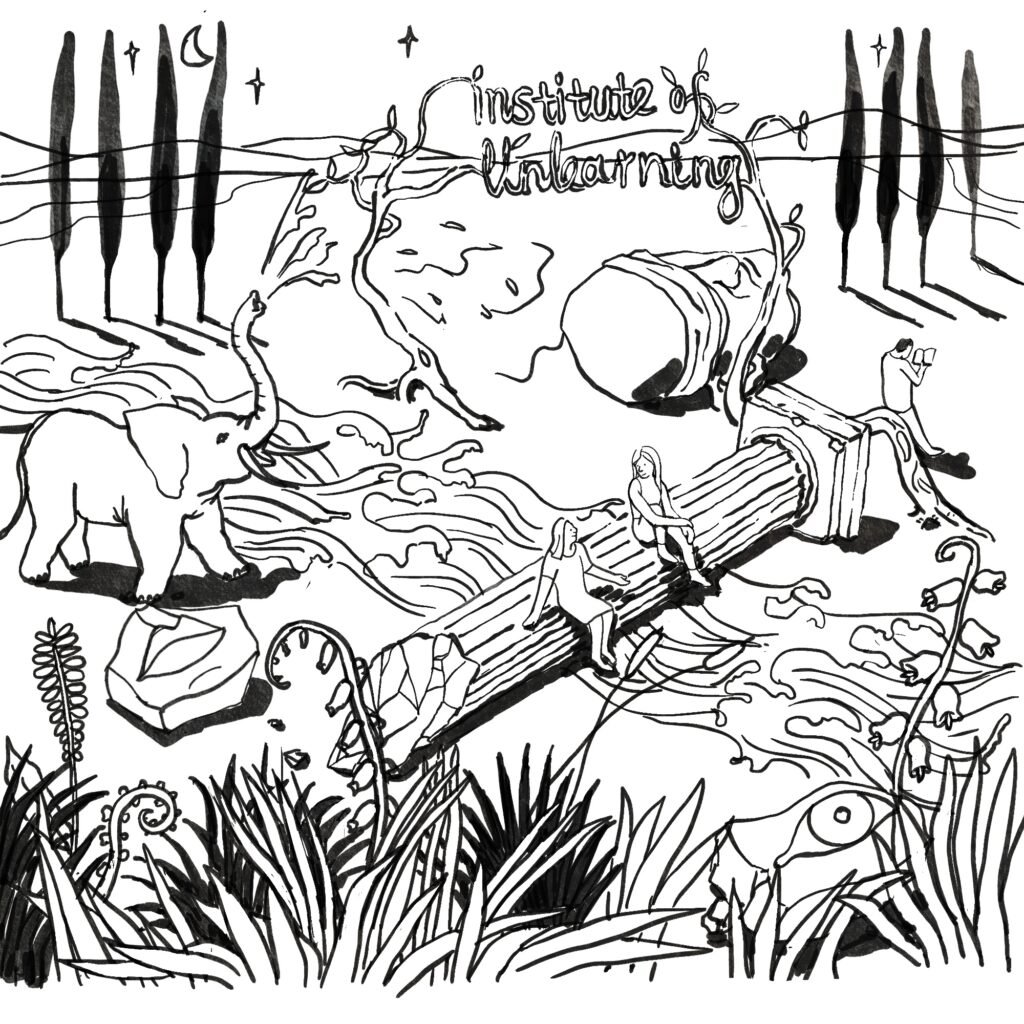Unlearning the Elephant: Against Multidisciplinarity
Institutions, the control of meaning, and the artist's potential to subvert the foundations of knowledge

epigraph
An artist is commissioned by a museum to collaborate with a scientist to create an artwork for an exhibition. Instead, the artist decides to meddle in his collaborator’s field of research and attempts to change its course. What the hell is he thinking?
Ever since I learned about Robert Irwin’s First National Symposium on Habitability of Environment of 1970, about 15 years ago, my processing of it runs in three parallel threads. One, quite immediate, has to do with the audacity, or even sheer arrogance, of Irwin’s creative act. This thread is developed, to a degree, in my interview with Irwin, which also contains the background information about the event.
Another thread has to do with the question: if we’d want to organize something like the Symposium on Habitability today, how should we go about it? Because by now, with the experience of the past 50 years, it seems to me that our biggest problem is not the lack of visionary multidisciplinary gatherings or one-off “experimental” events, but our disastrous inability to sustainably support the relationships and ideas these events generate. We (i.e., institutions: museums, universities, corporations) know well how to convene symposia, but we don’t know how to sustain and institute knowledge that is inclusive of the plurality of ways of knowing. This thread is the subject of my long-term project at the Weisman Art Museum. Talk to me if you want to have a conversation about it.
Finally, the third thread, developed over the years of my careers as an engineer, then artist, then curator, while reading every text about the Symposium I could lay my eyes on, is driven by the feeling that the terms assigned to it are somehow inappropriate: “Light and Space,” “art and science/technology,” “ephemeral”, “multi/trans/anti-disciplinary,” and so on. The present piece is an attempt to rescue the event from such art-historical designations, instead recasting Irwin’s act as a guerilla strategy for dismantling the cultural orthodoxies of knowledge. The parable of the blind men and an elephant, often used to rationalize the “interdisciplinary” approaches such as “Art and Science,” serves me here instead to illustrate their inadequacy.
In 1969, artist Robert Irwin was invited by the Los Angeles County Museum of Art (LACMA) to take part in the Art and Technology Project (A&T). About 70 artists were embedded in California corporations with the expectation that they would use laboratories as their studios and produce works for a museum exhibition at LACMA and the 1970 Expo in Kyoto, Japan. Irwin ended up in the Garrett Corporation, which at the time developed inhabitable capsules for the Apollo space program. There he met Dr. Edward (Ed) Wortz, a psychologist working on the subject of habitability, a research field about principles of designing habitable environments.
Painting was all that Irwin knew in his professional life then. Habitability, research, psychology, and outer space were as foreign to him as he was foreign to the corporate meeting rooms of Garrett. What he learned in these meeting rooms startled him. Most people he met considered no practical difference between inhabiting and surviving: if we supply you with enough oxygen, food, water, and so on, you’ll live and be productive, and that’s challenging enough to deal with. Irwin disagreed, and asked: but what about the human experience of inhabiting those new spaces?
At this same time, NASA commissioned Wortz to conduct a scholarly symposium on habitability, and Wortz invited Irwin to join the effort. Irwin suggested that presenting papers would not do: if we really want to change this conversation, we must find a way to mess with these people’s habitability, so that they feel with their own bodies what they are doing. Irwin refused to follow the assumed role of an artist as an external commentator, an inspirer, decorator, or critic, instead saying: I am a part of this system now, and I will fix it! The result was, I believe, one of the most remarkable events in contemporary art history, a roller coaster of a scientific gathering where nothing went as expected, conditions constantly changed, environments transformed, social contexts mixed, and artists ruled. Read about it in my interview with Irwin.
Irwin’s symposium did not lead NASA to change its attitude toward habitability, which remains principally the same 50 years later. The project was not represented in LACMA or Expo exhibitions either. The art form proposed by Irwin did not become part of mainstream artistic practices. For all intents and purposes, this project was a failure. The significance of Irwin’s experiment is not, therefore, in the value it created but in the value it could create: in its unrealized potential.
What is that potential?

The parable of the blind men and an elephant is frequently used as an illustration of multidisciplinary research. There is an elephant (say, in the room) and blind men surround it, each touching a different part of the animal. Subsequently, each man tells a different story that corresponds to the specific feature he touched. The moral is that only if we combine the stories of all [men] scholars will we know what the elephant really is. I would like to challenge this parable to demonstrate its inadequacies—and by extension the inadequacies of the paradigm of “multidisciplinarity,” as well as its permutations such as cross-, trans-, and even anti- or non-disciplinary, or any others that operate with “discipline” as a frame of reference.
But first: elephants, rooms, parables, and men do not exist in a vacuum, free of social relations and cultural frameworks. If we are to use this parable to describe accumulating and instituting knowledge, we should develop it further. First, we should agree to stop using blindness to represent inferior perception of the world: this is a product of conventions that measure people’s abilities with respect to the cultural “normal” and should not apply anymore if we take the idea of diverse perspectives on knowledge seriously. Let’s introduce blindfolded people instead (those blindfolds will come in handy later.) We should also stop using “man” as a synonym for “scholar,” for obvious reasons. The updated parable then begins with a group of blindfolded people surrounding an elephant in a room.
Not all blindfolded people are equal with respect to the elephant and knowledge about it. Some have more room to move and can touch more of the elephant’s body; some own the room where the elephant and the people are placed; some have the authority to admit—or not—other people into the room; some are descendants of those who brought the animal from the colonies to begin with and still control the grand narratives of the elephant; some still have financial stakes in the enterprise. Others in the room may question this entire arrangement and ask: why don’t you let us in your parts of the room so we have a better feel of the thing? Why don’t you give up ownership of the room (and the elephant) altogether so we don’t have to ask for permission? And did anyone ask the elephant if it wants to be touched? Can we learn about it without locking it up in the room?
The model of many perspectives building a full picture falls apart, and instead multitudes of cultures and worldviews emerge, with relationships of power and subversion among them. Power, because of the financial, institutional, and cultural control that some of the blindfolded people exercise over the process of learning. Subversion, because the worldviews and actions of other blindfolded people, mostly those with less power, may challenge the foundational premises of those with more.

The parable of the elephant has been used to rationalize an administrative solution to a deeply rooted social and cultural problem. The separation of knowledge to disciplines is not, as often suggested, a naturally evolved order of things for optimized learning. Rather, it is an instrument of exclusion that evolved for retaining control over the creation of meaning.1 Multidisciplinarity came about in the postwar period as an agenda of connecting knowledge silos to increase efficiency in pursuing ambitious goals (such as the Apollo program) without the danger of losing that control. It did that by promoting the fallacy that knowledge can be considered separately from cultural norms and institutions that govern knowledge, that disciplinary boundaries can be (temporarily) demolished while cultural and institutional ones remain intact.
Ariella Aïsha Azoulay described history as a discipline of telling plausible stories.2 I believe we should think about disciplines in general as devices for composing plausible stories; they do that by violently shredding worlds into pieces. Multidisciplinarity is an attempt to glue a few selected shreds together under the pretense of reconstructing the world.
But knowledge does not exist only within institutions3 (e.g., academic knowledge.) There are infinite forms of knowledge and ways of knowing practiced outside institutions. There is, then, another degree of power relationships to consider: between those within the institutions, who have the power and the authority over “institutional” knowledge, and those on the outside, who don’t have that power; those who are in the room with the elephant and those who are not; and those who enter the room for the first time, forgetting to wear the blindfold, look around, and ask: what elephant?
That was Robert Irwin vis à vis both NASA and LACMA.
The structure of the relationships between the blindfolded scholars does not acknowledge that outsiders might have agency in the conversation. Irwin’s intervention proposed a possibility, a model of how this could work. This possibility was enabled by unique circumstances in the arts in the mid–20th century, when an artist became free to do anything anywhere, to be anything and work with anyone—and still call the product art. One consequence of that freedom is that artists can connect, reframe, and subvert systems of knowledge.4 This is the potential of Irwin’s action, and the reason this conversation is relevant in the context of the arts. Irwin’s act was one of epistemological activism, of intentional instrumentalization of his art in an attempt to address a cultural problem and to create a new model of artistic engagement with society: that of a meta-scholar.

Back to our parable. Imagine: new developments in cognition studies have recognized elephants as intelligent and sentient beings, on par with humans. In response, a group of blindfolded scholars claims that continued objectification and the touching of elephants’ bodies for the sake of human knowledge is deeply unethical and must stop at once. Is there a possibility of reforming the elephant-room model and systems of relationships within it to address the new ethical concern? But the whole project of knowledge is inconceivable without the elephant in the room! And what about the myriads of other rooms with other elephants, and the mass manufacturing of blindfolds, and economical structures, funding mechanisms, cultural conventions, and so on, that have all evolved to enable things as they are? Can those all be reimagined for a new meaning-making paradigm that has elephants where they want to be and not where the blindfolded scholars want them?
The biggest obstacle seems to be not the logistics of the transition but the impression that, if we were to resolve the problem, the progress of knowledge should stop, because any new knowledge gained by touching the elephant would add insult to injury. To an extent, this impression is correct: the progress of knowledge as we know it might indeed have to stop.
Exit multidisciplinarity. Enter unlearning.
Unlearning is cultivating the imagination of what could have happened if the rich multiplicity of the world’s ways of knowing had not been crushed by the homogenizing violence of the imperial conquest. To unlearn is to empower the agency of this imagination, which encompasses not only what is known or knowable, but also how things are known.
Imagine the time before elephants were captured and placed in rooms. Imagine all the possibilities of learning that existed then, that did not involve indiscriminate touching of elephants’ bodies but rather collaborating and sharing the world and knowledge about it with them. Imagine all the possibilities of governing that multiplicity of knowing, sharing, and collaborating. Imagine all those multiple possibilities co-evolving into institutions of knowledge that are not founded in worlds shredded violently into legible pieces.5
For example, imagine an institution of knowledge capable of constantly recognizing and publicly acknowledging its inadequacies, and acting on those acknowledgments; an institution that constantly subverts itself. Imagine an institution of knowledge—a university, a museum, a corporation—that, rather than investing in yet more isolated multi/cross/trans/anti-disciplinary initiatives, departmentalized community outreach programs, and short-term artist residencies in an attempt to awkwardly glue a few selected shreds of the world together, instead refuses to accept this shredded reality as such.
For example, imagine institutions like LACMA and NASA actively inviting artists to interfere in their institutional and epistemological structures and publicly endorsing the transformation of their foundations.